By Aditi Pai, Jonah Comstock, & Brian Dolan
 Mobile health has come a long way since the start of 2009 when Apple demonstrated on-stage at its World Wide Developer Conference how blood pressure monitors and blood glucose meters could connect to the iPhone 3G via cables or Bluetooth. MobiHealthNews has tracked health-related wearable devices from their infancy as research projects at university labs to the commercially available products they are today. The past three Consumer Electronics Shows, especially, have yielded a wide range of smartphone-enabled health and fitness devices, from smart forks to connected pulse oximeters and, of course, the numerous wearable activity trackers.
Mobile health has come a long way since the start of 2009 when Apple demonstrated on-stage at its World Wide Developer Conference how blood pressure monitors and blood glucose meters could connect to the iPhone 3G via cables or Bluetooth. MobiHealthNews has tracked health-related wearable devices from their infancy as research projects at university labs to the commercially available products they are today. The past three Consumer Electronics Shows, especially, have yielded a wide range of smartphone-enabled health and fitness devices, from smart forks to connected pulse oximeters and, of course, the numerous wearable activity trackers.
While it's not yet fair to say that every wearable health-related device connects to smartphones, almost all of them have companion smartphone apps that display data collected by the device. The smartphone is the hub device for today's wearable devices.
As we're almost halfway through 2013, it seemed like a good time to stop and take a look back at the rise of smartphone-enabled health and fitness devices over the course of the past five years. Below is a comprehensive, but admittedly not exhaustive, timeline of important events and news announcements related to smartphone-enabled health and fitness devices.
Smartphone-enabled health devices in 2009
February 6, 2009: iTMP announces the launch of its Smheart Link device, a "wireless bridge for biometrics" that connects off the shelf fitness sensors like heart rate straps to a user's iPhone. The device launches with a $155 pricepoint. Read More
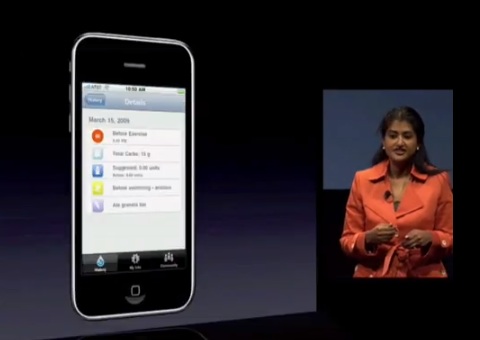 March 17, 2009: At Apple's World Wide Developers Conference, just before showing off a connected blood pressure monitor, Scott Forstall, SVP of iPhone Software at Apple gushes: ”Now here’s a class [of services] that we think will be really interesting: medical devices.” Forstall explained that the new iPhone OS will allow application developers to sync medical devices like BP monitors via both Bluetooth and USB. “So imagine the possibilities,” Forstall continues. “We think this is profound.” An exec from J&J company LifeScan then shows off a prototype of a blood glucose meter that connects to the iPhone to feed data into a companion app. Read More
March 17, 2009: At Apple's World Wide Developers Conference, just before showing off a connected blood pressure monitor, Scott Forstall, SVP of iPhone Software at Apple gushes: ”Now here’s a class [of services] that we think will be really interesting: medical devices.” Forstall explained that the new iPhone OS will allow application developers to sync medical devices like BP monitors via both Bluetooth and USB. “So imagine the possibilities,” Forstall continues. “We think this is profound.” An exec from J&J company LifeScan then shows off a prototype of a blood glucose meter that connects to the iPhone to feed data into a companion app. Read More
April 2, 2009: David Van Sickle, Robert Wood Johnson Foundation Health and Society Scholar in the Department of Population Health Sciences at the University of Wisconsin-Madison, reveals that he is developing a GPS add-on for asthmatics’ 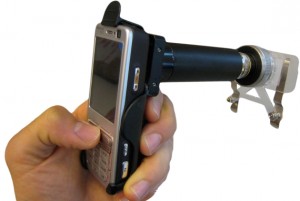 inhalers to map where and when environmental exposures cause asthma symptoms. The venture soon takes on the name Asthmapolis. Read More
inhalers to map where and when environmental exposures cause asthma symptoms. The venture soon takes on the name Asthmapolis. Read More
April 8, 2009: CellScope, in its earliest stages at UC Berkeley as a smartphone-enabled microscope with remote diagnosis potential, wins a Vodafone Americas Foundation award. Read More
July 16, 2009: Entra Health Systems announced its MyGlucoHealth Clinical Point-of-Care System, which is a clinic-based diabetic testing for in-patient care environments. The offering includes a cloud-based interface called Clinical Point-of-Care that works with the MyGlucoHealth meter to upload blood glucose tests and data through Bluetooth or USB to tablet computer, PC or compatible PDA device. Read More
September 30, 2009: French technology company Withings announces the US availability of its WiFi Body Scale that automatically records the user’s body weight, lean and fat mass, and calculated body mass index (BMI) to his/her secure webpage and/or free Withings iPhone application, WiScale. Read More
December 30, 2009: Australian mobile operator Telstra inks a deal with Entra to bring its smartphone-enabled diabetes system to that country. Read More
Smartphone-enabled health devices in 2010
April 7, 2010: Entra's MyGlucoHealth Diabetes App is now available on Nokia's app store, the Ovi Store. Read More
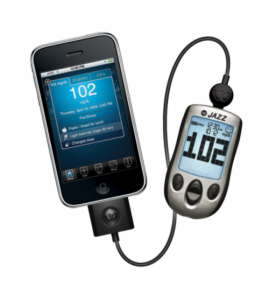 July 9, 2010: Salem, MA-based Agamatrix believes that its WaveSense Jazz meter could become the first medical device to connect directly to Apple’s iOS platform, which includes iPad, iPhone and iPod touch. Why isn’t the WaveSense Jazz meter already sending data to the iPhone app? Agamatrix says its new USB download cable, which connects the meter to the iPhone, is currently pending FDA 510(k) review. Read More
July 9, 2010: Salem, MA-based Agamatrix believes that its WaveSense Jazz meter could become the first medical device to connect directly to Apple’s iOS platform, which includes iPad, iPhone and iPod touch. Why isn’t the WaveSense Jazz meter already sending data to the iPhone app? Agamatrix says its new USB download cable, which connects the meter to the iPhone, is currently pending FDA 510(k) review. Read More
September 21, 2010: French pharmaceutical company Sanofi Aventis announced that it has tapped medical device maker Agamatrix to create blood glucose meter plug-in for Apple’s iPhone called iBGStar. Read More
October 7, 2010: BodyMedia announces plans for its new Bluetooth-enabled FIT Armband BW to transmit activity and other biometric data to BodyMedia users' smartphones for the first time.
December 15, 2010: FDA clears Zephyr's smartphone-enabled system: Zephyr’s OmniSense Mobile Smartphone based solution serves a broad array of applications from remote patient monitoring to employee safety. Read More
December 27, 2010: BodyMedia inks a deal with Jenny Craig that sees the weight loss company equipping some of its premium members with the wearable tracking company's FIT device.
 December 30, 2010: AliveCor's Dr. David Albert posts a video demo of his "iPhone ECG" device so a friend who couldn't make it an in-person demo at CES in Las Vegas the following month could check it out. The video goes viral and "Dr. Dave" ends up appearing on a number of talk shows and news programs as one of the breakout hits of CES that year. The device measures a single lead ECG from a custom iPhone case and transmits it via a mobile app on their iPhone. The case talks to the phone via a proprietary connectivity method. Video
December 30, 2010: AliveCor's Dr. David Albert posts a video demo of his "iPhone ECG" device so a friend who couldn't make it an in-person demo at CES in Las Vegas the following month could check it out. The video goes viral and "Dr. Dave" ends up appearing on a number of talk shows and news programs as one of the breakout hits of CES that year. The device measures a single lead ECG from a custom iPhone case and transmits it via a mobile app on their iPhone. The case talks to the phone via a proprietary connectivity method. Video
Smartphone-enabled health devices in 2011
January 3, 2011: BodyMedia announces a deal with Sprint that will add cellular connectivity to an upcoming version of its FIT Armband. The focus is always-on connectivity for the wearable that will stream data to BodyMedia's Android apps.
January 4, 2011: iHealth Lab, a San Francisco-based subsidiary of Chinese medical company Andon Health, announces the iHealth Blood Pressure Monitoring System for iPhone. The offering includes a battery-powered hardware dock, blood pressure arm cuff and a corresponding app. The system works with the iPhone, iPad and iPod touch and looks to be the first FDA-cleared medical device to head to Apple Stores. Read More
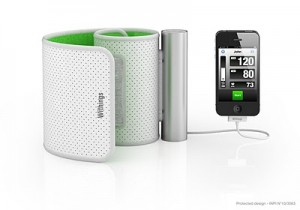 January 5, 2011: France-based Withings announces the launch of its own blood pressure monitor for the iPhone. Read More
January 5, 2011: France-based Withings announces the launch of its own blood pressure monitor for the iPhone. Read More
January 17, 2011: Dr. David Albert of AliveCor says that he has developed an Android version of its iPhoneECG device, too. Read More
January 20, 2011: The FDA clears the Withings iPhone blood pressure cuff as a Class II medical device. Read More
February 4, 2011: FDA clears the smartphone-enabled ultrasound probe system developed by Mobisante as a Class II device. The mobile ultrasound imaging system will cost between $7,000 and $8,000 in full, which includes a Toshiba Windows Mobile-powered smartphone, an ultrasound probe and the company’s software. Read More
June 23, 2011: Zephyr inks a deal with AT&T to add cellular connectivity to its remote monitoring offering. Read More
 July 13, 2011: San Francisco-based Jawbone, a company best known for fashion-minded Bluetooth headsets and iPod speakers, makes its first foray into the activity tracking space with the launch of its UP device. Jawbone hasn't yet revealed pricing or official launch date, but it describes UP as an end-to-end system that "consists of a small wristband that monitors your activity 24/7, a mobile app that analyzes the activity, and an open platform that motivates you with personal and social recommendations and challenges tailored to your goals." Read More
July 13, 2011: San Francisco-based Jawbone, a company best known for fashion-minded Bluetooth headsets and iPod speakers, makes its first foray into the activity tracking space with the launch of its UP device. Jawbone hasn't yet revealed pricing or official launch date, but it describes UP as an end-to-end system that "consists of a small wristband that monitors your activity 24/7, a mobile app that analyzes the activity, and an open platform that motivates you with personal and social recommendations and challenges tailored to your goals." Read More
July 14, 2011: Proteus Biomedical announces that it received a patent for its ingestible biomedical sensor — what the company has referred to as “intelligent medicine” in the past and what many have referred to as a “chip in a pill.” The sensor communicates through the person's body when it is swallowed and a patch on the patient's skin communicates the data to a companion smartphone app. Read More
September 26, 2011: Sleep monitoring and tracking company Zeo announces a new product, called Zeo Mobile, that enables users to capture data from their Zeo headband right to their smartphones -- no bedside display alarm clock needed. Read More
October 3, 2011: Fitbit launches its second generation activity tracker, Ultra, and its first iPhone app, which the wearable device does not connect to directly. Instead, the data is sent to Fitbit's online portal first via a wireless-enabled USB hub on the user's computer and the data is then updated for viewing via the app. Read More
 October 10, 2011: Mobisante commercially launches its smartphone-enabled ultrasound system about eight months after securing FDA clearance. Read More
October 10, 2011: Mobisante commercially launches its smartphone-enabled ultrasound system about eight months after securing FDA clearance. Read More
November 3, 2011: Jawbone commercially launches its first iteration of UP. Read More
November 9, 2011: Scanadu, a San Francisco-based startup that aims to develop a handheld smartphone-connected diagnostic device similar to the Star Trek tricorder, raises $2 million from a number of angel investors, including Playfish co-founder Sebastien De Halleux. Read More
November 23, 2011: Mountain View, California-based Glooko announces 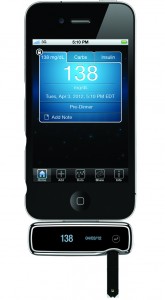 plans for a cord that will connect various off the shelf glucometers with the iPhone. The team includes a former Lifescan executive who led the J&J company's own iPhone-enabled glucose meter app initiative. Read More
plans for a cord that will connect various off the shelf glucometers with the iPhone. The team includes a former Lifescan executive who led the J&J company's own iPhone-enabled glucose meter app initiative. Read More
December 7, 2011: The FDA clears AgaMatrix’s iPhone-enabled glucose meter iBGStar, which is codeveloped with French pharmaceutical company Sanofi. The companies began offering the device in Europe earlier this year. In Europe it is available in Germany, France, Switzerland, the Netherlands and Italy. Read More
December 9, 2011: Jawbone announces that it will temporarily halt making its UP device because of issues with battery life and syncing with the device's companion smartphone app. Read More




















